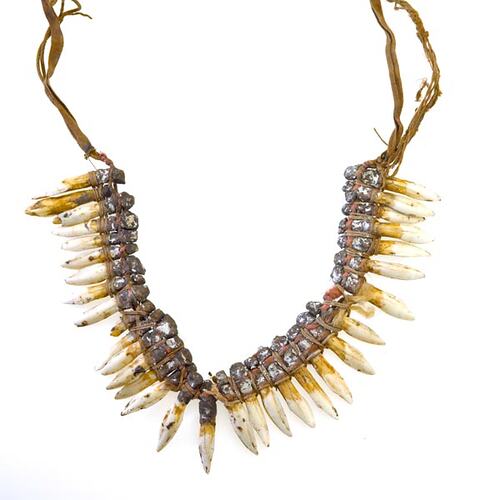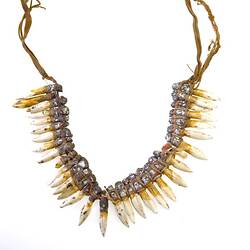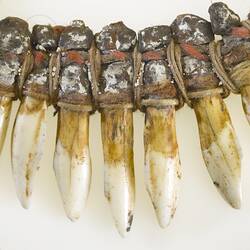Summary
Aboriginal people of central and northern Australia produced a variety of body ornaments for both ceremonial and decorative purposes, some were exchanged across vast trade networks, and others were 'sung' to give them certain magical powers. This forehead ornament was made using the incisor teeth of kangaroos, with each tooth being embedded in a small lump of beeswax, and then attached side by side on double-stranded string made of vegetable fibre. Among some Aboriginal groups forehead ornaments featuring kangaroo teeth were worn mostly by women. This ornament was worn with the points of the teeth hanging down. Spencer and his collaborator in Alice Springs, Frank Gillen recorded Aboriginal people using another method to make a forehead ornament with kangaroo teeth involving embedding the teeth in a small mass of resin from the leaf stalks of a species of 'Triodia', commonly known as spinifex or porcupine grass. String made from human hair was also fastened to the resin to tie behind the wearer's head. Spencer and Gillen also recorded rows of kangaroo teeth embedded in resin and tied onto Aboriginal necklets in the Northern Territory. In this case the teeth were usually coated with pipe clay to make them stand out. Animal parts were not uncommon in Aboriginal ornaments in central Australia, with a range of parts being used including bone, fur and feathers from various birds.
Physical Description
An ornament consisting of kangaroo incisors set in beeswax. Each tooth is tied with vegetable string and attached to the next one. The ties attached at either end are strips of dyed cotton cloth.
More Information
-
Object/Medium
Ornament, head
-
Maker
-
Locality
-
Date Produced
-
Date Collected
-
Object Measurements
450 mm (Length), 95 mm (Width), 30 mm (Height)
-
Keywords
-
Collection Names
-
Type of item
-
Discipline
-
Category
-
Collecting Areas
Australian Indigenous - Northern Australia and Queensland and Torres Strait Islands



